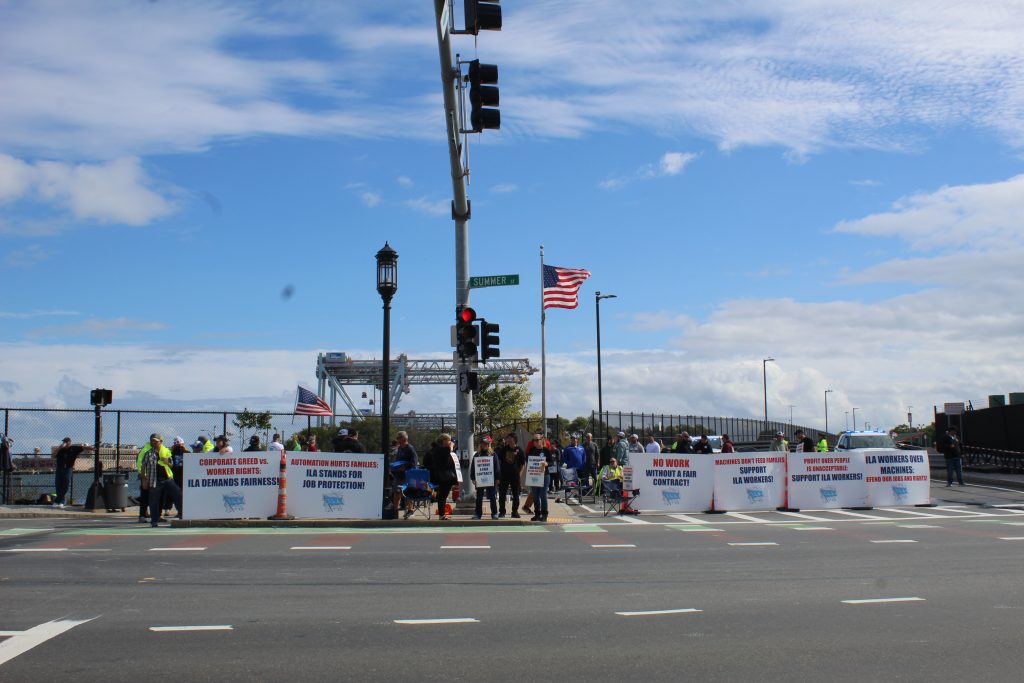[[{“value”:”
By Connor Wright
SOUTHIE – Dockworkers in the International Longshoremen’s Association (ILA) have called off their coast-wide strike, after reaching a temporary back-to-work agreement with the U.S. Maritime Association (USMX). The three-day strike was the first shutdown of East Coast ports in almost 50 years.
Roughly 300 Boston dockworkers were among those on strike. Five Boston-area ILA locals picketed Conley Terminal in South Boston, starting Monday and ending on Wednesday night when the ILA and USMX went public with the agreement.
The deal includes a 62% wage increase for dockworkers over the 6-year life of the contract, not far from the union’s original demand of 77%. In exchange, the ILA is extending the terms of the current contract until January 15, to give the union and the USMX more time to bargain a full tentative agreement.
Hotly contested issues are still under negotiation, especially the ILA’s ongoing fight against the automation of dock work. But celebrations broke out on picket lines up and down the coast on Wednesday night, as workers cheered this blow against the shipping companies.
If the ILA and USMX can’t reach an agreement by January 15, dockworkers may hit the picket lines again. That depends on how negotiations play out over the next three months, and how rank-and-file dockworkers judge whatever gains are made in the full tentative agreement.
Movement on Wages, Automation Still a Fight
The strike has been fought on two main issues: wages and automation.
The union has won most of what it demanded on wages, although the new wage scale would have ILA members just starting to pull even with dockworkers in the more radical, West Coast-based ILWU. But automation is an even bigger sticking point – and one the shipping companies are much less likely to give up on.
Automation has been an issue on the docks since the 1960s, when “containerization” (standardized shipping containers) revolutionized work on the docks and helped shipping companies – in the words of one industry website – “shed costly labor.”
In the past, dockworkers’ unions have accepted some level of automation. The ILWU, under the leadership of socialist Harry Bridges, compromised with the West Coast shippers in a series of negotiations in the 1960s, agreeing not to fight job losses from containerized shipping in exchange for massive increases in wages and benefits for the union’s existing membership.
The ILA largely followed suit – although with rampant corruption and mob control in most ILA locals, and a collaborationist approach toward employers, their wage increases were paltry compared to those won by the left-wing ILWU.
Many of these problems, including accusations of a continued organized crime presence, still plague the ILA today. To this day, West Coast dockworkers enjoy higher pay and stronger contracts, and even during the strike, ILA president Harold Daggett faced resurfaced allegations of mob ties and living a luxuriant lifestyle on member dues.
Now dockworkers on both coasts are fighting shippers’ moves toward “fully automated ports” – a process of mechanization that would cut even more union jobs from the docks than were lost through containerization.
At the time of writing, no public agreements have been made on automation in the ILA’s ongoing negotiations with shipping employers.
The Biden Administration Quietly Avoids a Strike
The dockworkers’ ability to shut down the ports was the biggest factor in winning a wage concession from the shipping companies. Without a credible strike threat, the USMX would hold most of the power in bargaining, and could have stonewalled the ILA as long as it wanted to on key demands.
But the strike wasn’t just a contest between the dockworkers and their bosses. The Biden administration has been heavily involved in the negotiations, and played a major role in the deal announced on Thursday.
According to a report from the Washington Post, Biden officials like acting Labor Secretary Julie Su and chief economic advisor Lael Brainard have been meeting with employers and union officials for months, hoping to avoid a major disruption to the economy so close to the presidential election.
These officials’ main intervention seems to have been pressuring USMX to boost their wage proposals to the ILA. It produced some movement early on, when late last month the USMX proposed a roughly 50% raise over six years. But ILA officers dismissed the offer as “fail[ing] to address the needs of our members adequately,” and the strike went ahead.
On the day of the strike deadline, Biden announced support for the ILA’s aims, calling on the USMX to “present a fair offer.” But even more significant than what he did is what he didn’t do – invoke the Taft-Hartley Act.
Under Taft-Hartley – a major anti-union law passed in 1947, and still on the books today – the President has the authority to declare a “national emergency” in major labor conflicts, forcing workers back to work for a 90-day “cooling off” period and locking the striking union into government-mediated arbitration.
Presidents from both major parties have used this law to suppress strikes 37 times since it was passed, against workers from many different industries. The repression and forced arbitration of Taft-Hartley was a major factor in the decline of strikes and the weakening of the U.S. labor movement, with effects that are still felt today.
The last time Taft-Hartley was invoked was in 2002, when George W. Bush used it to quash another major dockworkers’ strike by the ILWU on the West Coast. This easily could have been precedent for Biden, but the administration decided not to use the law. Biden even told a press conference during the strike, “I don’t believe in Taft-Hartley.”
Not only did Biden not break the strike, his officials kept up pressure on employers, both public and private, to move even further on wages. According to the Washington Post report, after an all-night call that lasted until 5:30 in the morning, White House chief of staff Jeff Zients told shipping executives he would tell the President that the USMX was making a new, higher wage offer to the union.
A source close to the shipping employers told Freightwave magazine that they treated this ultimatum as “marching orders” from the Biden administration. They quickly proposed the 62% raise and accepted the back-to-work plan.
The Politics of a Port Strike
Although in step with Biden’s general pro-union image, Biden’s strategy in the ILA strike was different from his approach to the last labor conflict that threatened a major disruption to U.S. commerce.
In the fall of 2022, during a major contract fight by railroad workers, Biden pushed legislation through Congress forcing a weak contract on rail workers, despite 55% of members across the dozen or so rail unions voting against the deal negotiated by rail union leadership.
So why didn’t Biden intervene to stop the strike? Why did his officials consistently pressure employers instead of the ILA?
One factor is the differences between ILA and the rail unions. The ILA is a single industrial union that has almost all ports on the East Coast and the Gulf organized. Rail workers, on the other hand, are divvied up into a dozen or so competing craft unions, making large-scale actions like an industry-wide strike far more difficult.
The ILA’s low current wage standards are another factor. The 62% figure is impressive on first sight, but it still leaves East Coast dockworkers below the standard set by the ILWU on the West Coast. The pressure put on the USMX was real, but the wage concession was less dramatic than the Post and other mainstream outlets made it out to be.
It’s also important to note that extending the current contract, and agreeing to call off the strike, was a major concession on the ILA’s part. Like most union contracts, the ILA’s contains a no-strike clause, which is now back in effect. That was the quid pro quo in Biden’s deal – a decent agreement on wages, but in exchange for the union giving up their most powerful tool.
The presidential election was likely another major factor. A prolonged strike could have caused shortages, inflation, job losses – a major economic disruption just weeks away from a presidential election in which Biden, Kamala Harris, and the Democrats would be held responsible.
But trying to avoid the strike by locking the ILA into arbitration would have sparked a highly public dispute with the dockworkers, and could have complicated relations with important parts of the U.S. labor movement, which largely supported the strike.
The Democratic Party has been bleeding working-class support for decades. Despite some genuine pro-union moves from the Biden administration – from a more aggressive NLRB to his public support of the UAW strike – Republicans’ growing advantage with workers is hard to ignore. The 1.3 million-member Teamsters union even put out internal polling showing a whopping 58% support Donald Trump for President, over just 31% for Kamala Harris.
It’s possible that the Teamsters poll being released – and that union’s non-endorsement in the presidential race – factored into the administration’s thinking. The Teamsters represent a similar demographic of workers to the ILA: non-college educated, blue-collar industrial workers – exactly the demographic Democrats have struggled to attract. And Kamala Harris is on track to perform worse with union voters than Biden in 2020 or Hillary Clinton in 2016.
Altogether, Biden’s moves in this strike led to the best possible outcome for his administration and Kamala Harris’s presidential bid. Biden avoided a drawn-out strike, put off the thorny struggle over automation until after the election, and shored up the Democrats’ bona fides with a demographic they may need to put them over the edge in the presidential race.
The Fight Continues for Dockworkers
As for the dockworkers, a lot is up in the air. They have won a wage increase, but their job security is still on the line, and they have given up a big part of their leverage by agreeing to go back to work.
Whether the ILA can win restrictions on further automation – either at the bargaining table or back on the picket line – is unclear. The fight against automation and job loss has been a long-term one for U.S. labor., including the rise of “artificial intelligence” that played a major role in the recent actors’ and writers’ strikes.
A lot depends on how negotiations unfold over the next 90 days, and – if they stall again – the ILA’s willingness to take their members back on strike.
Connor Wright is a member of Boston DSA and a labor reporter for Working Mass.
“}]]

